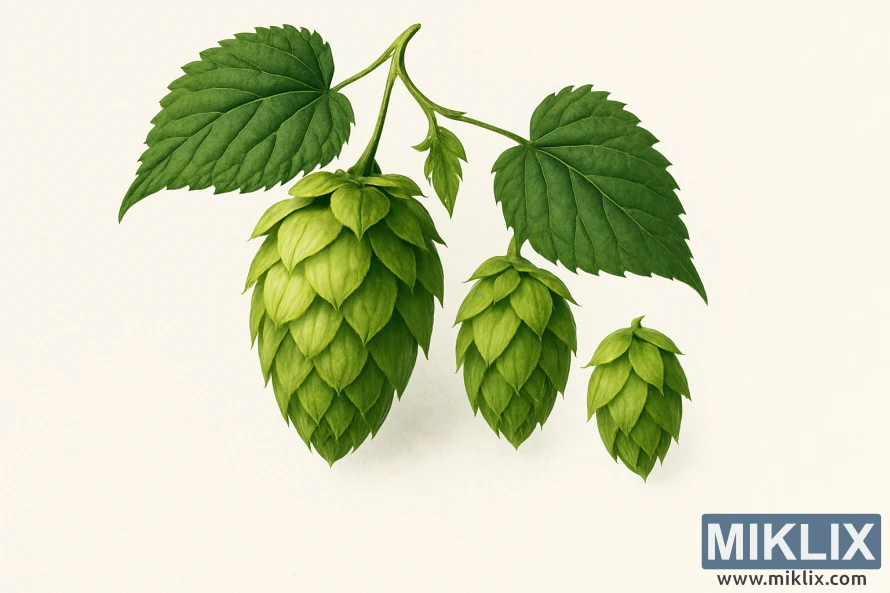Image: Topaz Hop Flavor Profile
Published: August 6, 2025 at 5:00:04 PM UTC
Last updated: September 27, 2025 at 9:08:05 AM UTC
Detailed illustration of Topaz hops with vibrant green cones, highlighting citrus, pine, and floral notes that define their unique flavor profile.
The image presents itself as both scientific study and artistic homage, a meticulously detailed botanical illustration of hop cones that captures their essence with almost meditative clarity. Three fully developed hop cones hang gracefully from their stems, each rendered with striking precision, while two accompanying leaves spread outward in confident, natural symmetry. The cones are depicted in various stages of growth, ranging from the largest, whose overlapping bracts cascade downward like the layered scales of a pinecone, to the smaller, more compact cones that still hold the energy of youth. Their verdant hues span a spectrum of greens, from pale lime at the delicate tips of the petals to deeper, more saturated tones near the base, conveying not only their physical form but also a sense of their inner vitality. Against the stark, neutral background, their details emerge with heightened intensity, every vein, every fold, and every contour highlighted as though under the gaze of both botanist and brewer alike.
What makes the image compelling is not simply its visual accuracy but the way it conveys the sensory world locked within these cones. One can almost imagine the delicate lupulin glands nestled deep inside the bracts, tiny reservoirs of sticky golden resin that hold the aromatic soul of the hop. The composition allows the mind to wander toward the scents that these cones might exude if crushed gently between the fingers: the bright burst of citrus zest, the grounding notes of resinous pine, the soft lift of florals that whisper of meadows in bloom. For the Topaz hop variety in particular, this spectrum extends into unexpected territory, offering hints of tropical lychee, earthy spice, and even a subtle thread of black tea, a complex bouquet that this illustration seems to allude to in its vibrant, almost tactile detail.
The neutral background plays a vital role in the composition, stripping away distractions and emphasizing the cones and leaves as the true protagonists. Without a landscape, brewing kettle, or farm scene to contextualize them, the hops are presented as timeless, essential forms—raw ingredients distilled to their purest identity. This isolation mirrors the way a brewer or sensory analyst might study hops during evaluation, examining their structure, inhaling their aroma, and contemplating how their qualities will transform when added to a boil, whirlpool, or dry hop. The careful balance of cones and leaves, with their graceful curves and natural proportions, reflects a quiet orderliness, suggesting not just the chaos of nature but the harmony humans have long found within it.
Beyond its role as visual representation, the illustration evokes something more enduring: the dialogue between plant and product, between the earthy fields where hops are cultivated and the glass of beer in which they find their voice. In capturing the cones with such care and simplicity, the image highlights the hop as both agricultural marvel and cornerstone of brewing tradition. There is a sense of reverence in the way the cones are allowed to breathe within the composition, as if they are icons of a craft that spans centuries. They become more than plants; they are symbols of creativity, experimentation, and the unending search for balance in flavor and aroma.
Ultimately, the mood is one of precision and admiration. The artist or illustrator has chosen not to overwhelm the viewer with context but instead to focus on the beauty of the cones themselves, allowing their natural geometry to speak volumes. The Topaz hop variety, known for its versatility in both bittering and aroma applications, emerges here as both scientific specimen and aesthetic muse. This duality—art and science, agriculture and craft, simplicity and complexity—is woven into the composition itself. Through its clean lines, rich hues, and serene balance, the illustration invites us to pause, observe, and appreciate the hop not only for what it gives to beer but for what it is: a living, breathing expression of nature’s ability to create complexity within simplicity.
The image is related to: Hops in Beer Brewing: Topaz

